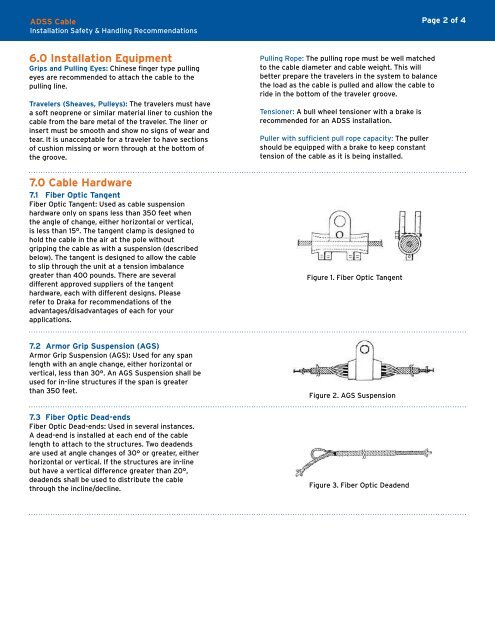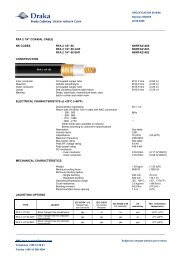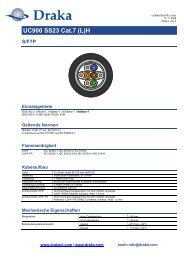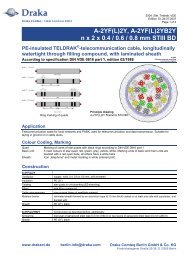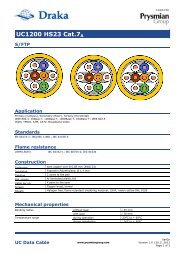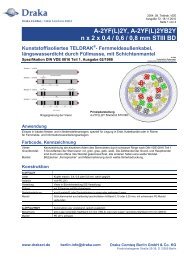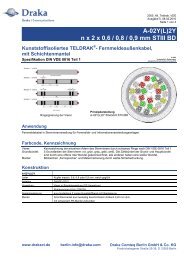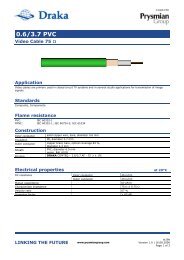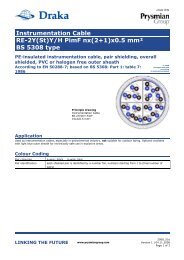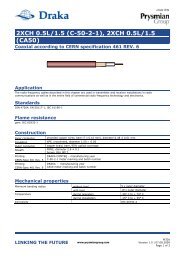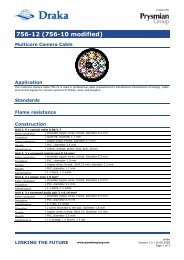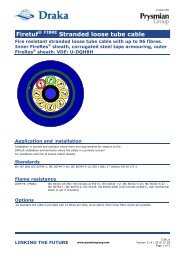ADSS Cable - Draka Communications
ADSS Cable - Draka Communications
ADSS Cable - Draka Communications
You also want an ePaper? Increase the reach of your titles
YUMPU automatically turns print PDFs into web optimized ePapers that Google loves.
<strong>ADSS</strong> <strong>Cable</strong><br />
Installation Safety & Handling Recommendations<br />
6.0 Installation Equipment<br />
Grips and Pulling Eyes: Chinese finger type pulling<br />
eyes are recommended to attach the cable to the<br />
pulling line.<br />
Travelers (Sheaves, Pulleys): The travelers must have<br />
a soft neoprene or similar material liner to cushion the<br />
cable from the bare metal of the traveler. The liner or<br />
insert must be smooth and show no signs of wear and<br />
tear. It is unacceptable for a traveler to have sections<br />
of cushion missing or worn through at the bottom of<br />
the groove.<br />
damage to the ripcords, armor, buffer tubes, and fibers.<br />
7.0 <strong>Cable</strong> Hardware<br />
7.1 Fiber Optic Tangent<br />
Fiber Optic Tangent: Used as cable suspension<br />
hardware only on spans less than 350 feet when<br />
the angle of change, either horizontal or vertical,<br />
is less than 15°. The tangent clamp is designed to<br />
hold the cable in the air at the pole without<br />
gripping the cable as with a suspension (described<br />
below). The tangent is designed to allow the cable<br />
to slip through the unit at a tension imbalance<br />
greater than 400 pounds. There are several<br />
different approved suppliers of the tangent<br />
hardware, each with different designs. Please<br />
refer to <strong>Draka</strong> for recommendations of the<br />
advantages/disadvantages of each for your<br />
applications.<br />
7.2 Armor Grip Suspension (AGS)<br />
Armor Grip Suspension (AGS): Used for any span<br />
length with an angle change, either horizontal or<br />
vertical, less than 30°. An AGS Suspension shall be<br />
used for in-line structures if the span is greater<br />
than 350 feet.<br />
7.3 Fiber Optic Dead-ends<br />
Fiber Optic Dead-ends: Used in several instances.<br />
A dead-end is installed at each end of the cable<br />
length to attach to the structures. Two deadends<br />
are used at angle changes of 30° or greater, either<br />
horizontal or vertical. If the structures are in-line<br />
but have a vertical difference greater than 20°,<br />
deadends shall be used to distribute the cable<br />
through the incline/decline.<br />
Pulling Rope: The pulling rope must be well matched<br />
to the cable diameter and cable weight. This will<br />
better prepare the travelers in the system to balance<br />
the load as the cable is pulled and allow the cable to<br />
ride in the bottom of the traveler groove.<br />
Tensioner: A bull wheel tensioner with a brake is<br />
recommended for an <strong>ADSS</strong> installation.<br />
Puller with sufficient pull rope capacity: The puller<br />
should be equipped with a brake to keep constant<br />
tension of the cable as it is being installed.<br />
Figure 1. Fiber Optic Tangent<br />
Figure 2. AGS Suspension<br />
Figure 3. Fiber Optic Deadend<br />
Page 2 of 4


